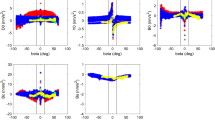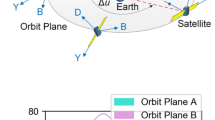Abstract
This paper introduces a new approach for modeling solar radiation pressure (SRP) effects on Global Navigation Satellite Systems (GNSSs). It focuses on the Galileo In-Orbit Validation (IOV) satellites, for which obvious SRP modeling deficits can be identified in presently available precise orbit products. To overcome these problems, the estimation of empirical accelerations in the Sun direction (D), solar panel axis (Y) and the orthogonal (B) axis is complemented by an a priori model accounting for the contribution of the rectangular spacecraft body. Other than the GPS satellites, which comprise an almost cubic body, the Galileo IOV satellites exhibit a notably rectangular shape with a ratio of about 2:1 for the main body axes. Use of the a priori box model allows to properly model the varying cross section exposed to the Sun during yaw-steering attitude mode and helps to remove systematic once-per-revolution orbit errors that have so far affected the Galileo orbit determination. Parameters of a simple a priori cuboid model suitable for the IOV satellites are established from the analysis of a long-term set of GNSS observations collected with the global network of the Multi-GNSS Experiment of the International GNSS Service. The model is finally demonstrated to reduce the peak magnitude of radial orbit errors from presently 20 cm down to 5 cm outside eclipse phases.













Similar content being viewed by others
References
Agueda A, Zandbergen R (2004) NAPEOS mathematical models and algorithms. In: Technical Report, NAPEOS-MM-01, iss. 3.0, 04/06/2004, ESA/ESOC, Darmstadt.
Bar-Sever Y, Kuang D (2004) New empirically derived solar radiation pressure model for Global Positioning System satellites. In: Technical Report, 42–159, IPN Progress Report.
Bar-Sever YE (1996) A new model for GPS yaw attitude. J Geod 70(11):714–723. doi:10.1007/BF00867149
Bar-Sever YE, Russ KM (1997) New and improved solar radiation models for GPS satellites based on flight data. In: Technical Report, Task Plan 80–4193, Jet Propulsion Laboratory.
Beutler G (2005) Methods of Celestial Mechanics. Springer, Berlin
Beutler G, Brockmann E, Gurtner W, Hugentobler U, Mervart L, Rothacher M, Verdun A (1994) Extended orbit modeling techniques at the CODE processing center of the international GPS service for geodynamics (IGS): Theory and initial results. Manuscr Geod 19:367–386
Beutler G, Jäggi A, Hugentobler U, Mervart L (2006) Efficient satellite orbit modelling using pseudo-stochastic parameters. J Geod 80(7):353–372. doi:10.1007/s00190-006-0072-6
Binda S, Fletcher K (eds) (2011) GIOVE experimentation results: a success story. ESA SP-1320.
Chiarini JC, Smith D, Perren M, Nakache JM, Palumbo S, Gatti G, Bramante A, Emma F, Prieto RG, Alpe V et al (2003) The Galileo satellite. In: 21st International Communications Satellite Systems Conference and Exhibit, AIAA, 2003–2306, pp 1–10. doi:10.2514/6.2003-2306.
Colombo OL (1989) The dynamics of Global Positioning System orbits and the determination of precise ephemerides. J Geophys Res 94(B7):9167–9182. doi:10.1029/JB094iB07p09167
Dow JM, Neilan RE, Rizos C (2009) The International GNSS Service in a changing landscape of Global Navigation Satellite Systems. J Geod 83(3–4):191–198. doi:10.1007/s00190-008-0300-3
Eanes R, Nerem R, Abusali P, Bamford W, Key K, Ries J, Schutz B (2000) Glonass orbit determination at the Center for Space Research. In: Proceedings of the International GLONASS Experiment (IGEX-98) Workshop, IGS, Jet Propulsion Laboratory.
Feng W, Guo X, Qiu H, Zhang J, Dong K (2014) A study of analytical solar radiation pressure modeling for BeiDou navigation satellites based on raytracing method. In: China Satellite Navigation Conference (CSNC) 2014 Proceedings: Volume II, Springer, Lecture Notes in Electrical Engineering, vol 304, pp 425–435. doi:10.1007/978-3-642-54743-0_35.
Fliegel HF, Gallini TE (1996) Solar force modeling of block IIR Global Positioning System satellites. J Spacecr Rockets 33(6):863–866. doi:10.2514/3.26851
Fliegel HF, Gallini TE, Swift ER (1992) Global Positioning System radiation force model for geodetic applications. J Geophys Res 97(B1):559–568. doi:10.1029/91JB02564
Hackel S, Steigenberger P, Hugentobler U, Uhlemann M, Montenbruck O (2014) Galileo orbit determination using combined GNSS and SLR observations. GPS Solut. doi:10.1007/s10291-013-0361-5 (online first)
IGS (2014) http://acc.igs.org/reprocess2.html. Last accessed 22 Aug 2014
Ikari S, Ebinuma T, Funase R, Nakasuka S (2013) An evaluation of solar radiation pressure models for QZS-1 precise orbit determination. In: Proceedings of ION GNSS. ION, Nashville, pp 1234–1241
Konrad A, Fischer HD, Muller C, Oesterlin W (2007) Attitude and orbit control system for Galileo IOV. Autom Control Aerosp 17(1):25–30. doi:10.3182/20070625-5-FR-2916.00006
Kouba J, Héroux P (2001) Precise point positioning using IGS orbit and clock products. GPS Solut 5(2):12–28
Marquis W, Krier C (2000) Examination of the GPS block IIR solar pressure model. In: Proceedings of ION GPS. ION, Salt Lake City, pp 407–415
Milani A, Nobili AM, Farinella P (1987) Non-gravitational perturbations and satellite geodesy. Adam Hilger Ltd., Bristol
Montenbruck O, Steigenberger P, Schönemann E, Hauschild A, Hugentobler U, Dach R, Becker M (2012) Flight characterization of new generation GNSS satellite clocks. Navigation 59(4):291–302
Montenbruck O, Steigenberger P, Kirchner G (2013) GNSS satellite orbit validation using satellite laser ranging. In: Proceedings of the 18th International Workshop on Laser Ranging, Fujiyoshida
Pearlman M, Degnan J, Bosworth J (2002) The International Laser Ranging Service. Adv Space Res 30(2):125–143. doi:10.1016/S0273-1177(02)00277-6
Píriz R, Fernández V, Auz A, Tavella P, Sesia I, Cerretto G, Falcone M, Navarro D, Hahn J, González F, Tossaint M, Gandara M (2006) The Galileo System Test Bed V2 for orbit and clock modeling. In: Proceedings of ION GNSS, Fort Worth, pp 549–562
Prange L, Dach R, Lutz S, Schaer S, Jäggi A (2014) The CODE MGEX orbit and clock solution. In: Willis P (ed) IAG Potsdam 2013 Proceedings. Springer, International Association of Geodesy Symposia, accepted for publication.
Rodriguez-Solano C, Hugentobler U, Steigenberger P, Lutz S (2012a) Impact of earth radiation pressure on GPS position estimates. J Geod 86(5):309–317. doi:10.1007/s00190-011-0517-4
Rodriguez-Solano C, Hugentobler U, Steigenberger P, Bloßfeld M, Fritsche M (2014) Reducing the draconitic errors in GNSS geodetic products. J Geod 88(6):559–574. doi:10.1007/s00190-014-0704-1
Rodriguez-Solano CJ, Hugentobler U, Steigenberger P (2012) Adjustable box-wing model for solar radiation pressure impacting GPS satellites. Adv Space Res 49(7):1113–1128. doi:10.1016/j.asr.2012.01.016
Schönemann E, Springer T, Otten M, Becker M, Dow J (2007) GIOVE: a precise orbit determination from microwave and satellite laser ranging data—first perspectives for the Galileo constellation and its scientific use. In: 1st Colloquium on the Scientific and Fundamental Aspects of the Galileo Program, ESA
Springer T, Beutler G, Rothacher M (1999) A new solar radiation pressure model for GPS satellites. GPS Solut 2(3):50–62
Steigenberger P, Hugentobler U, Montenbruck O, Hauschild A (2011) Precise orbit determination of GIOVE-B based on the CONGO network. J Geod 85(6):357–365. doi:10.1007/s00190-011-0443-5
Steigenberger P, Hugentobler U, Loyer S, Perosanz F, Prange L, Dach R, Uhlemann M, Gendt G, Montenbruck O (2014) Galileo orbit and clock quality of the IGS Multi-GNSS Experiment. Adv Space Res. doi:10.1016/j.asr.2014.06.030 (online first)
Svehla D, Schönemann E, Escobar D, Springer T (2010) Complete relativistic modelling of the GIOVE-B clock parameters and its impact on POD, track-to-track ambiguity resolution and precise timing applications. In: IGS Analysis Center Workshop 2010, Newcastle
Waller P, Gonzalez F, Binda S, Sesia I, Hidalgo I, Tobias G, Tavella P (2010) The in-orbit performances of GIOVE clocks. IEEE Trans Ultrason Ferroelectr Freq Control 57(3):738–745. doi:10.1109/TUFFC.2010.1472
Weiss J, Bar-Sever Y, Bertiger W, Desai S, Garcia-Fernandez M, Haines B, Kuang D, Selle C, Sibois A, Sibthorpe A (2014) Orbit and attitude modeling at the JPL analysis center. In: IGS Workshop 2014, Pasadena
Wu SC, Yunck T, Thornton C (1991) Reduced-dynamic technique for precise orbit determination of low earth satellites. J Guid Control Dyn 14(1):24–30. doi:10.2514/3.20600
Ziebart M (2004) Generalized analytical solar radiation pressure modeling algorithm for spacecraft of complex shape. J Spacecr Rockets 41(5):840–848. doi:10.2514/1.13097
Ziebart M, Dare P (2001) Analytical solar radiation pressure modelling for GLONASS using a pixel array. J Geod 75(11):587–599. doi:10.1007/s001900000136
Ziebart M, Adhya S, Sibthorpe A, Cross P (2003) GPS block IIR non-conservative force modeling: computation and implications. In: ION GPS 2003, Portland, pp 2671–2678.
Acknowledgments
This study is based on Galileo observations collected by the Multi-GNSS Experiment (MGEX) of the International GNSS Service (IGS). The support of all participating station providers and data centers is gratefully acknowledged. The authors are, furthermore, grateful to the International Satellite Laser Ranging Service (ILRS) for making available the SLR observations used in the orbit validation of the Galileo satellites. The European Space Agency (ESA) and the Astronomical Institute of the University of Bern (AIUB) are acknowledged for granting access to their NAPEOS and Bernese software packages.
Author information
Authors and Affiliations
Corresponding author
Rights and permissions
About this article
Cite this article
Montenbruck, O., Steigenberger, P. & Hugentobler, U. Enhanced solar radiation pressure modeling for Galileo satellites. J Geod 89, 283–297 (2015). https://doi.org/10.1007/s00190-014-0774-0
Received:
Accepted:
Published:
Issue Date:
DOI: https://doi.org/10.1007/s00190-014-0774-0




